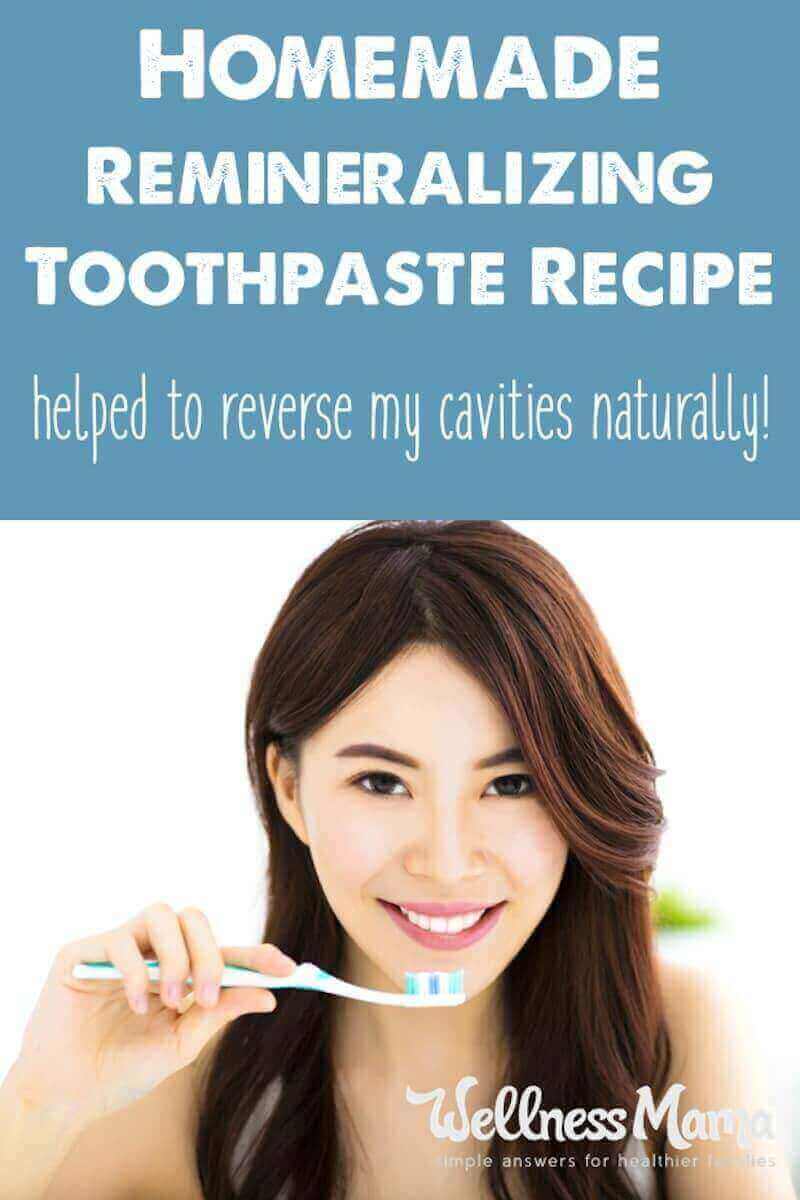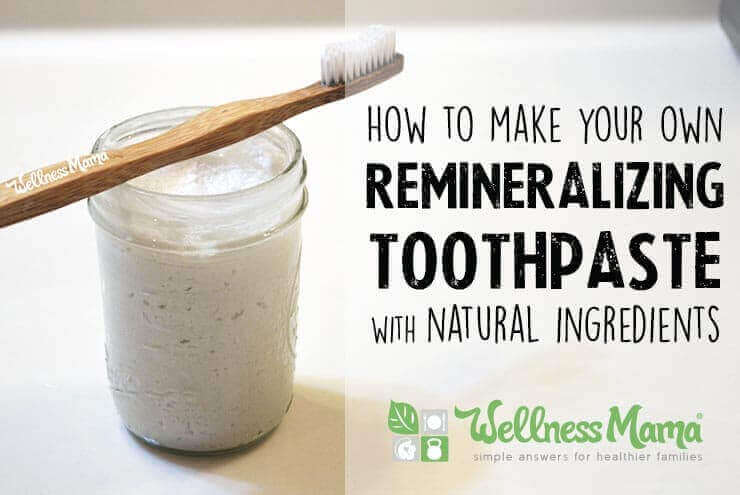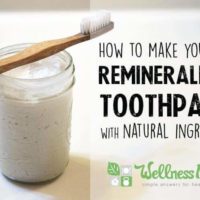I’ve talked before about the link between nutrition and oral health and the ability of teeth to remineralize and regenerate and shared my own experience with reversing a cavity. The approach I used was two-part: addressing mineral levels in the body/saliva and using a natural remineralizing toothpaste that provided minerals to the surface of the teeth.
A Remineralizing Toothpaste
There is a lot of emerging information about tooth remineralization, a process that many dentists previously thought was impossible. This article goes into detail about the science behind tooth remineralization and the dietary steps necessary. (It also explains why ingredients in most toothpastes, even natural ones, are not optimal!) I also did a podcast interview with a dentist who explains the science of remineralization (listen here).
The information I found in researching this was mirrored by my own experience over the last few years with natural toothpastes and a remineralizing diet.
Natural Toothpaste
I’ve noticed definite changes in my teeth over the last few years of using this toothpaste. My teeth are whiter than they’ve ever been and everyone who I’ve asked to try this remineralizing toothpaste has remarked that it makes their teeth feel very clean.
The most surprising change in my teeth, however, was that they are no longer sensitive to cold! For as long as I can remember, biting into anything cold (or even thinking of it!) made me shudder and hurt my front teeth. After switching toothpaste, I noticed that I could eat cold foods without my teeth hurting at all. I have never been able to do that before!
This toothpaste recipe is kid-approved, and since it has no fluoride, it is safe on babies, toddlers, and those with thyroid problems.
Remineralizing Toothpaste Recipe
Materials
- 5 parts calcium carbonate powder (you can use cleaned powdered egg shells!)
- 1 part diatomaceous earth (optional, contains trace minerals and silica. UPDATE: A reader noted that DE can be abrasive and is not needed with the baking soda, so if you don’t have DE… no worries!)
- 2 parts baking soda
- 3 parts xylitol powder (optional, helps with taste)
- 3-5 parts coconut oil
- essential oils (such as mint, cinnamon, orange, and myrrh, optional)
Instructions
- In a bowl, mix together the calcium powder, diatomaceous earth, baking soda, and xylitol.
- Add the coconut oil one part at a time until the desired consistency is reached.
- Add any optional essential oils for flavor.
- Store in small container such as a ½ pint glass jar.
- To use, either dip a clean toothbrush into it, or use a popsicle stick or small spoon to scoop it onto the toothbrush.
Notes
The Internal Side of Remineralization
It is really important to note that remineralization is not a process that happens only in the mouth and that simply using a toothpaste (like the one above) with a higher concentration of minerals will not likely be enough to help teeth. Remineralization is a whole-body process and in order for it to happen, the body must have adequate levels of certain nutrients, especially fat-soluble vitamins and certain minerals.
When I was actively working on remineralizing my teeth, I focused on consuming a very specific nutrient-rich diet, reducing mineral binders like phytic acid in the foods I ate, and adding other lifestyle factors that boosted nutrient levels.
You can read my daily oral health routine in this post.
These additional factors like consuming enough minerals and fat-soluble vitamins are important not only because they support the body as a whole, but also because they create more mineral-rich saliva, which is the body’s delivery system for necessary nutrients to the teeth.
How Saliva Benefits Oral Health
In short: Saliva is the way teeth remineralize!
On a practical level, teeth are remineralized through the saliva being washed over the teeth. Without proper nutrient levels in the body, saliva will also be deficient in the minerals teeth need for optimal strength. Clearly, we must have sufficient nutrition in our diet in order to have the necessary minerals present in the saliva to support remineralization.
The importance of enough saliva for the prevention of tooth decay is well established. There are multiple theories about the origin of tooth decay:
- That decay occurs due to acids from bacteria in the mouth digesting sugars; or
- That tooth decay occurs when there is an imbalance between the demineralization of the enamel surface and remineralization produced by the return of mineral ions into enamel (as explained by Rami Nagel in his book, Cure Tooth Decay)
Whichever theory is correct, saliva is important, as the frequent stimulation of saliva, especially after the intake of sugars, will help to dilute and buffer plaque acid, bring extra mineral ions into the plaque fluid and thereby promote remineralization.
Saliva Reduces Bacteria that Cause Gum Disease and Tooth Decay
Research shows a clear relationship between declining saliva production with age and the increased risk of gum disease with age. Saliva contains a whole host of vital substances for our immune system.
For example, lactoferrin is one compound naturally found in saliva. Lactoferrin is part of our innate immune system and is one of our key front lines of defense. Lactoferrin binds iron in the mouth depriving the gum-damaging bacteria the iron necessary for them to flourish.
Saliva is also a rich source of necessary enzymes. Of the salivary enzymes involved in maintaining the ecology of the mouth, one of the first to be recognized was the enzyme lysozyme, which appears to work by destabilizing the cell wall of bacteria that cause tooth decay and gum disease.
Saliva Reestablishes Healthy pH in the Mouth
The mouth has its own complex ecology that must be kept in balance for optimal oral health. This includes a bacterial aspect, the presence of enough minerals, and maintaining the proper pH. While we can most effectively address optimizing the pH of the mouth through immune supporting protocols like a nutrient dense diet, restful sleep, and healthy coping tools for stress, saliva clearly plays a key role in the actual mechanism of establishing what the pH of our mouth is going to be at any given time.
How to Increase Saliva Production
The principle “Use it or Lose it” applies when discussing saliva production. We must exercise our ability to produce saliva or deal with a dry mouth and all the ails that come with decreased saliva production.
While we naturally produce additional saliva when eating, the extra benefits to our health of the increased saliva are offset by the main job of saliva during eating, to begin the digestion process. Therefore, it can be helpful to increase saliva production through other methods, like this:
Step 1: Gather any saliva in your mouth into a pool on your tongue. Now using the musculature of the throat, draw the saliva back and forth from the back of the tongue to just behind the front teeth then back again several times (we recommend 30-50 repetitions). With practice, this action will increase the amount of saliva present in the mouth.
Step 2: Once you have a large pool of saliva on your tongue, give your teeth and gums a bath with your increased saliva! We call swishing with saliva “swashing” because it’s like you are swishing and washing at the same time. Swash with the increased saliva for a minute or two then swallow it down and let the saliva now support greater digestion in the stomach!
This is such a simple technique even young children can do it. This video explains more:
Using a natural toothpaste can also help increase saliva production. I’ve noticed a saliva increase with this remineralizing toothpaste, and also with the OraWellness Brushing Blend.
Ever made your own toothpaste? Share your recipe and thoughts below!




Leave a Reply